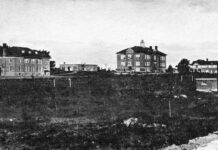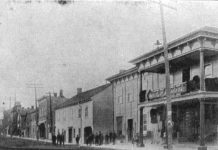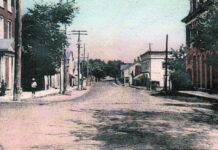Before 1830, the Rideau River roared over the rapids below the present dam, providing the water power that allowed the community to grow up around grist and woolen mills. A bridge had been built across the river in 1824, the first to span the Rideau River.
It had been built by Eli Hurd, and £100 had been granted for purpose by the Legislative Assembly. Hurd was actually only paid £50, and the Bridge Commissioners, Walter Gates and Henry Burritt, asked to use the balance of the grant to pay for a bridge between Wolford and Montague.
At that time, there was no island at all: where the canal flows today was a dry hollow or channel running almost a mile and a half parallel to the river. It is most likely that this channel was flooded each spring as the narrow passage of the rapids was overwhelmed by the high waters. But aside from that short period, the channel was a dry creek.
When Colonel John By was reconnoitering the route of the Rideau Canal in 1829, he noted this channel, which was called the Oxford Snie, and realized that it would make an excellent means of bypassing the rapids. By building a dam upstream from the settlement, the Rideau waters were backed up and forced down the Snie instead. Locks were built at the far end of the snie to control water levels in the new canal channel. Once the snie was flooded, the new island came into being, and the village of Burritts Rapids would grow up on the newly separated land.
Burritt’s Rapids is a divided place: part of it lies in North Grenville, and the rest, north of the river, is part of the City of Ottawa. There was, however, at least one very serious attempt to end that division. In November, 1854, the Legislative Assembly of the Province of Canada – Parliament of the day – received a petition from John Strachan French, and others, asking that the island of Burritt’s Rapids, “certain Lots in the 1st Concession of the Township of Oxford”, be detached from that township and transferred to Marlborough. This was a serious petition: French was one of the earliest settlers of the village, and owned a great deal of the land and commerce of the village. He had bought the large grist mill, as well as the saw and shingle mill, on the river bank in 1840. Around the same time, he had built a large store (now the Community Hall) on the Mill Site, as well as the large house across the street.
Other businessmen of the village were far from convinced of the wisdom of French’s plans. William Kidd was another important entrepreneur of Burritt’s Rapids. In March, 1855, Kidd, backed by the Municipality of the Township of Oxford, sent a petition to the Assembly asking that “no alteration or separation may be effected with respect to the boundaries of the said Township of Oxford”. French submitted a second petition on March 26, signed by residents of the Village of Burritt’s Rapids and asking “that a portion of the Township of Oxford be annexed to the County of Carleton”. Basil Church, Reform Member for North Leeds and Grenville, introduced a Private Member’s Bill in favour of French’s petition to annex Burritt’s Rapids to Carleton County. The Bill, “to detach a certain island at Burritt’s Rapids from the Township of Oxford, in the County of Grenville, and to annex the same to the Township of Marlborough in the County of Carleton”, was read a first and second time, and then referred to the Committee on Miscellaneous Private Bills. And there it died a silent death, left Unresolved. The island of Burritt’s Rapids, literally carved out of Oxford Township, remained part of that Township. And so the Village remains today, separate, divided, a unique place in so many ways.









